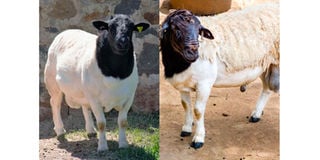Dorper vs Somali blackhead sheep; know difference

Sheep is not a very valued ruminant livestock in Kenya except for the Dorper and the Somali black headed sheep. Dorper meat, usually pronounced “Doba” at eateries, is very popular. The Somali blackheaded sheep, on the other hand, is popular in areas inhabited by Kenyans of Somali extraction, mainly upper Eastern and North Eastern regions.
As the name suggests, the sheep is a native of Somalia. But it is also native to Kenya, Ethiopia and Djibouti. Outside the area of the sheep’s origin, its meat is liked in the Middle East.
Of late, I have increasingly got enquiries from farmers and potential farmers wanting to know the most suitable sheep for meat production. A number of them have specifically wanted to know the difference between the two black headed sheep.
Incidentally, many people erroneously believe any sheep with a black head and a white body is a Dorper. The Dorper is a champion meat sheep not only in Kenya but also in many other parts of the world.
The breed was developed in South Africa from 1940–1950 from the Persian Black Head and the Dorset Horn sheep, hence its name Dorper. The aim was to create a sheep breed highly productive in meat, resistant to diseases and adaptable to hot arid areas. It attained all those characteristics and more. For instance, it is highly adaptable to cold climates as well. In South Africa, it is also called a Dorsian.
Meat production
Due to its great success in breeding, meat production and environmental adaptability, the Dorper quickly spread in South Africa and other parts of the world, including Namibia, Zimbabwe, Malawi and Kenya. It is crossed the seas to Australia, America and Israel.
Except for the colour distribution, the Dorper and the Somali black headed sheep are easily distinguishable. Dorpers have a long compact rectangular body that is very well-muscled. The legs are relatively short and stocky. The nose is aquiline or what is called a Roman nose, curved and akin to the eagle’s beak.
Due to its origin from a wool and hair sheep, the Dorper coat is made of both wool and hair. The mixture of wool and hair covers mainly the back and sides and tends to shear off naturally during the hot season. The underside and the legs are covered with crisp short hair.
The sheep has a black head and neck with a white body. Some Dorpers have a uniform snow white body. The type is rare and is called the “White Dorper”. Some people tend to value it more due to its elegance.
One beauty about the Dorper is that it is able to utilise feeds that other livestock, including sheep, do not find useful such as crop residues and dry grass. It is resistant to attacks by flies and wool rot. However, the sheep is highly vulnerable to the blood-sucking stomach worms called Haemonchus contortus. In my practice, I have found the worm to be a major cause of mortality in the sheep and their lambs. The worms are, however, easily controlled using dewormers.
Dorper meat is of very good flavour and fat content. The sheep is able to produce high quality meat even when fed on pasture. Dorpers have low twinning rate of about 10 per cent but have a high fertility rate. Their rate of pregnancy in a flock is about 80 per cent. They also breed at any time of the year.
The Dorper is one of the largest breeds of sheep weighing about 100 to 130kg live weight. The males are heavier than the females. It is a fast-grower putting up about 36kg at three to four months of age. It also has a high carcass yield of about 54 per cent. This means a 36kg lamb would yield about 20kg of meat on bone.
The climatic adaptability of the Dorper, high disease resistance, high fertility, fast-growth rate and high carcass yield are key characteristics that make the sheep breed highly suitable for mutton production in Kenya and other parts of the world.
Breed purity
Dorpers are readily available in Kenya in pure breed, crosses and mixes. The price of a Dorper may go up to Sh50,000 depending on the breed purity of the specific sheep and the purpose of buying. Breeding sheep are more expensive than those for slaughter. Prices of Dorper sheep for slaughter range from Sh6,500 to Sh25,000 depending on the age, size and body condition of the animal.
The Somali Blackhead, on the other hand, is also called the Somali fat-tail, Somalia or Berbera sheep. Its head is black and body white. The coat is all hair. The nose is straight, unlike the Dorper. The body is narrow without a defined shape.
The legs are thin and long. The tail is fat, making the ramp appear exaggerated. The sheep stores fat in the tail as food reserves for the dry season. It is one of the small sheep breeds, weighing about 70 to 80kg. The sheep does well in dry areas.





